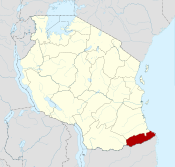- Mtwara Region
-
- This article is about the region, for the city see Mtwara (city).
Mtwara is a southern region of Tanzania which has been underdeveloped for a long time: development is constrained by the lack of highway and energy infrastructures. The Dar es Salaam-Kibiti-Lindi-Mtwara road has been improved by the completion of the Mkapa bridge over the Rufiji River. Mnazi Bay gas promises to provide reliable and adequate electricity for powering industrial and commercial activities in the region.[citation needed]
The boundary with Mozambique to the south is formed by the Ruvuma River. To the west Mtwara is bordered by Ruvuma Region, to the north by Lindi Region, and to the east is the Indian Ocean. The capital is Mtwara.
According to the 2002 Tanzania National Census, the population of the Mtwara Region was 1,128,523.[1]
The regional commissioner is H.Shekifu[2]
Contents
History
The Groundnut Scheme
In 1948, the British Government formulated the "Tanganyika groundnut scheme" through the Overseas Food Corporation (OFC). The purpose was to alleviate the worldwide shortage of vegetable oils; however, inadequate research and adverse environmental conditions due to poor planning resulted in the complete and disastrous failure of the scheme. The exported crop was to go through the port of Mtwara.
Districts
Mtwara Region is administratively divided into six districts: Masasi, Nanyumbu, Newala, Tandahimba, Mtwara Urban and Mtwara Rural.
Sources
- Mtwara Region Homepage for the 2002 Tanzania National Census
- Tanzanian Government Directory Database
- Commonwealth Forestry News, December 2000
Regions of Tanzania Arusha · Dar es Salaam · Dodoma · Iringa · Kagera · Kigoma · Kilimanjaro · Lindi · Manyara · Mara · Mbeya · Morogoro · Mtwara · Mwanza · North Pemba · Pwani · Rukwa · Ruvuma · Shinyanga · Singida · South Pemba · Tabora · Tanga · Zanzibar Central/South · Zanzibar North · Zanzibar Urban/West

Coordinates: 10°40′S 39°00′E / 10.667°S 39°E
Categories:- Mtwara Region
- Regions of Tanzania
- Tanzania geography stubs
Wikimedia Foundation. 2010.

